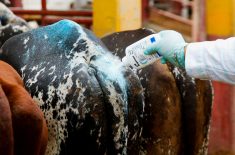Chicago Mercantile Exchange live cattle futures settled lower on Tuesday in all contracts except spot December as traders evened positions on the last trading day of 2013, but the market overall posted gains of 3.5 per cent for the year.
CME live cattle for December delivery, which expired at noon CT, settled up 0.1 cent per hundredweight (cwt) at 134.5 cents (all figures US$). The contract hit an 11-1/2 month high.
February, the new lead month, ended down 0.475 cents per pound at 134.625 cents and near an 11-month top. April finished at 135.3 cents, 0.45 cent lower.
Read Also

U.S. grains: Soy futures post biggest monthly gain in nearly five years on China trade optimism
U.S. soybean futures climbed to a 15-month high and posted their biggest monthly gain in nearly five years on Friday following a rally fueled by the prospect of revived exports to China.
Live cattle futures have gained for five years straight, culminating in record-high cash cattle prices on Friday due to tight supplies.
Fewer cattle are available after years of drought in parts of the U.S. sent feed costs up sharply last summer, which forced ranchers to downsize their herds.
Last week, cash cattle in Texas fetched mostly $133.50/cwt, feedlot sources said. They reported sales of mostly $133 in Kansas and $135 in Nebraska a week ago.
No cash cattle bids or asking prices were reported by feedlot sources for this week.
The scarcity in cattle resulted in less beef on the market and fed competition for tight supplies among end-users who want to feature beef after Jan. 1.
Tuesday morning’s wholesale price, or cutout, for choice beef rose $1.13 per cwt from Monday to $200.84, and select gained 60 cents to $196.06, according to the U.S. Department of Agriculture.
The firm cash tone and surprising improvement in cutout values could cause packers to pay more for cattle this week, Allendale Inc. president Paul Georgy said.
Packers plan to slow down slaughter rates to avoid higher cash cattle prices, recover lost margins and further boost wholesale beef values.
Beef packer margins for Tuesday were estimated at a negative $84.30 per head, compared with a negative $88.25 per head on Monday and negative $77.25 a week ago, as calculated by HedgersEdge.com.
Weaker live cattle futures pressured CME feeder cattle. Still, those contracts were up 10.3 per cent on the year thanks to less-costly feed.
Cheaper corn encourages feedlots to buy young cattle for fattening.
Feeder cattle for January closed at 166.7 cents/lb., down 0.575 cent, and March finished at 167.4 cents, 0.55 cent lower.
Hog futures up as shorts cover
CME hogs gained modestly and were up 1.7 per cent for the year fueled by short-covering, traders said.
February hogs closed 0.45 cent/lb. higher at 85.425 cents, and April ended up 0.225 cent at 90.675 cents.
The fact that cash hog prices were mixed rather than lower, and higher wholesale pork values, helped pull up nearby hog futures.
The afternoon’s average hog price in the western Midwest was up nine cents/cwt from Monday at $77.06, but $1.86 higher in the eastern region at $77.99, according to USDA.
While some processors are sorting through ample supplies of heavyweight hogs, others are booking hogs for Saturday and early next week.
The afternoon’s wholesale pork price climbed 74 cents/cwt from Monday to $84.37, according to USDA.
Supermarkets are gearing up for early January pork features, a trader said.
Processors may be funneling pork into storage in case the spread of the porcine epidemic diarrhea virus, which is fatal to baby pigs, significantly reduces 2014 spring and summer supplies, he said.
— Theopolis Waters reports on livestock futures markets for Reuters from Chicago.











